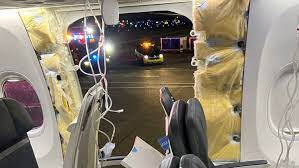Following a terrifying flight in which an Alaska Airlines airplane was left with a gaping hole in its side, federal officials said on Saturday that some Boeing 737 Max aircraft would be temporarily grounded. This development has raised concerns about the safety of Boeing’s best-selling aircraft.
According to the Federal Aviation Administration, certain Max 9 aircraft flown in the country by foreign carriers or operated by American airlines must undergo emergency inspections.
The FAA’s emergency order, which it stated would impact roughly 171 aircraft globally, is the most recent setback for Boeing related to the Max series of aircraft, which was involved in two fatal crashes not long after it was introduced.
Seven minutes after takeoff from Portland, Oregon on Friday, an Alaska Airlines Boeing 737 Max 9 experienced a fuselage panel blowout. The sudden decrease in cabin pressure resulted in oxygen masks falling from the ceiling and a child’s clothes being yanked off, but amazingly, none of the 171 passengers or six crew members suffered any injuries. During an emergency, the pilots safely landed.
Alaska Airlines declared it would ground its entire fleet of 65 Max 9 aircraft for maintenance and inspections just hours after the horrifying event. Alaska anticipates that the inspections will be finished “in the next few days,” according to CEO Ben Minicucci.
Alaska announced on Saturday that following extensive, recent maintenance, the impacted areas on 18 of its Max 9s were evaluated and found to be in good enough condition to resume passenger service.
Over 25% of Alaska’s fleet consists of Max 9 aircraft, thus even the brief suspension caused significant disruptions to both the airline and its passengers. By late morning on the West Coast on Saturday, Alaska had canceled almost 100 flights, or 15% of its scheduled itinerary, according to FlightAware.
About 60 flights were canceled as a result of United Airlines taking the 79 Max 9s out of service, the airline said after inspecting 33 of the aircraft.
Images displayed a gap where an emergency escape is often placed in aircraft that are designed to accommodate a maximum number of passengers. Due to a shortage of seats in its 737 Max 9 aircraft, Alaska closes those exits, negating the need for an additional emergency escape.
The event on Friday will be looked into, according to the National Transportation Safety Board and the Federal Aviation Administration.
A request for an executive to be accessible for remarks was turned down by Boeing. The Arlington, Virginia-based business declared in a statement that it agreed with the FAA’s decision to mandate inspections right away. Boeing said that it was offering the investigators technological assistance.
Analysts predicted that the cause of the blast would determine how much harm Boeing’s brand would sustain.
Longtime aerospace expert and consultant Richard Aboulafia stated that Boeing may face more pressure to alter its procedures if the blowout is linked to a manufacturing problem, and the company may see a delay in the cash-generating delivery of new aircraft.
However, Aboulafia stated that “unless the situation is worse than it seems,” he does not anticipate any change in Boeing’s sales of the aircraft. In response to the increased demand for travel during the pandemic, airlines are acquiring new, more fuel-efficient aircraft from Boeing and Airbus.
The aircraft involved in the incident on Friday is a brand-new model; according to flight-tracking website Flightradar24, it has only performed 145 flights since it started transporting passengers in November.
The Max is the most recent iteration of Boeing’s legendary 737, a twin-engine, single-aisle aircraft that is widely utilized on domestic flights within the United States. The Max 8 and Max 9 differ mostly in size.
Boeing pondered creating a whole new aircraft to replace the 737 more than ten years ago. However, fearing a decline in sales to rival Airbus of Europe, which was offering a more fuel-efficient version of its comparably sized A320, Boeing chose to pursue the easier route of making changes to the 737, giving rise to the Max.
In 2018, a Lion Air Max 8 aircraft crashed in Indonesia, and in 2019, an Ethiopian Airlines Max 8 aircraft crashed in Ethiopia. For over two years, the aircraft was grounded by regulators worldwide while Boeing modified an automatic flight control system that was linked to the crashes.
Congress and federal prosecutors questioned if Boeing had taken shortcuts to expedite approval of the Max while requiring pilots to have the bare minimum of training. In 2021, Boeing agreed to pay $2.5 billion, which included a $244 million fine, to resolve a criminal probe. The business accused two comparatively low-level workers of misleading the Federal Aviation Administration about the flight-control system’s shortcomings.
The relatives of the passengers killed in the Ethiopian tragedy are being represented by Chicago attorney Robert Clifford, who said that Friday’s occurrence made people wonder if authorities were hasty in allowing the Max planes to resume flying. He accused Boeing of prioritizing money over security.
He remarked, “This is a company that went from being the pinnacle of engineering precision and expertise to a company that seems to be at the bottom of the barrel.”
According to financial estimates, Boeing has estimated that the aftermath of two deadly disasters has cost the company over $20 billion. With the majority of the relatives of the passengers who perished in the crashes, it has achieved private settlements.
Following the crashes, there was a gap before airlines started purchasing the Max. However, the aircraft has been beset by issues unconnected to the burst on Friday.
Delivery delays have occasionally resulted from supplier inquiries concerning components. The FAA warned pilots last year not to use the Max’s anti-ice system too often in dry weather because of a worry that the inlets surrounding the engines would overheat and break away, potentially damaging the aircraft. Additionally, Boeing instructed airlines to check the aircraft in December for a potential loose bolt in the rudder-control system.
In 2018, a South-west Airlines passenger lost her life when a fragment of the engine housing fell off and broke the window next to her. But that was not a Max; it was an earlier model of the Boeing 737.

















